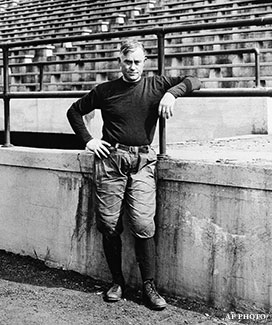
The Rich Rodriguez chapter of Michigan football history is over, and it won’t be remembered fondly. Rodriguez will be recalled not only for losing games, but for getting his program placed on probation for practicing too much. What most Michigan fans don’t know, however, is that their team has endured a much more drastic form of discipline. The Wolverines were actually kicked out of the Intercollegiate Conference of Faculty Representatives -- the forerunner to the Big Ten -- in 1907.
Why? Well, for playing too much football.
With player safety a chief concern in the first decade of the 20th century, what was colloquially called the “Western Conference” or “Big Nine” at the time decided to limit its members to five football games a season. Michigan had played as many as 13 games in the 1905 season and didn’t take kindly to cutting non-conference schools such as Oberlin and Drake from its slate. These days, Michigan’s approach would be commended for “strength of schedule.” But a century ago? Not so much.
Then, as now, The New York Times was on the case:
athletics because of its refusal to observe conference rules, and all athletic relations between the
university and the other colleges composing the conference were severed. It was insisted by the
other members of the intercollegiate conference that the rules adopted at the close of the football
season of 1905, limiting the time of all athletes to three years, and the number of football games
to not more than five, should be observed by Michigan, or that university should be left out of
the conference. The representatives of Michigan declined to promise that the university would
observe these rules, and it was then announced that all athletic relations had been terminated.
Michigan had earned at least a share of the conference title in five of the six seasons from 1901- 1906 under coach Fielding Yost (pictured at the top of the post).* With Michigan out of the picture, Amos Alonzo Stagg’s Maroons at the University of Chicago benefited with back-to-back conference titles. Later, Ohio State -- which had to give up its rivalry with Michigan when it joined the conference in 1912 -- won its first conference championship in 1916.
Perhaps the biggest beneficiaries of Michigan’s leaving the conference, though, were its in-state rivals. Since the Wolverines couldn’t schedule any of their old conference mates, they searched for new opponents, beginning an annual series with Michigan Agricultural – soon to become Michigan State -- in 1907. The two schools have met in all but three years since. The existence of the rivalry was one reason the Spartans were chosen to fill Chicago’s place in the conference in 1950.
Ten years after leaving, Michigan rejoined the Intercollegiate Conference of Faculty Representatives, pushing its membership to 10 for the first time and prompting its by now familiar (and official) name. Yost and the Wolverines were back on top of the conference with a shared title by 1918. Michigan can only hope Brady Hoke can return it to the top of the Big Ten just as quickly.
* The Wolverines lost out on the conference title in 1905 when they dropped their
13th and final game of the season, 2-0, to Chicago. The deciding safety was the only score Michigan
allowed during a season in which it outscored its opponents, 495-2.




